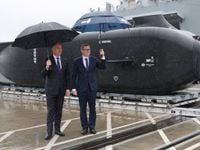Australia has made a decisive leap into the future of naval warfare, announcing on September 10, 2025, a $1.1 billion USD investment in a fleet of domestically designed and built autonomous submarines known as Ghost Sharks. The move, described by officials as a response to "the most threatening strategic landscape since the end of the Second World War," signals a dramatic shift in the country's defense priorities and technological ambitions, according to Reuters.
The announcement came at the Royal Australian Navy base HMAS Kuttabul in Sydney, where Deputy Prime Minister and Minister for Defence Richard Marles and Minister for Defence Industry Pat Conroy stood beside one of the sleek, unmanned Ghost Shark Extra Large Autonomous Undersea Vehicles (XL-AUVs). The display was not just for show—it marked a public commitment to developing what Marles called "the highest tech capability in the world."
"This is a profoundly important capability for the Royal Australian Navy," Marles told assembled reporters, as quoted by Al Jazeera. "We have consistently articulated that Australia faces the most complex, in some ways, the most threatening, strategic landscape that we have had since the end of the second world war." His words echoed growing concerns in Canberra about the shifting balance of power in the Asia Pacific region, particularly as China flexes its military muscle with increasingly assertive moves and displays.
The five-year contract, valued at 1.7 billion Australian dollars, has been signed with Anduril Australia, a company at the forefront of defense innovation. The deal covers not only the building of the Ghost Shark drones but also their ongoing maintenance and further development—all to be done on Australian soil. This domestic focus is a nod to both national security and local industry, as dozens of Ghost Sharks are set to be constructed in Australia, with potential for export to allied nations, according to Minister Conroy.
The new fleet of Ghost Sharks is designed to operate autonomously, supplementing Australia’s existing naval surface fleet and its plans for sophisticated nuclear-powered submarines. Marles emphasized that these uncrewed undersea vehicles will "complement Australia’s naval surface fleet and submarines to provide a more capable and more lethal navy." The drones boast "very long range" and advanced stealth capabilities, making them a formidable addition to Australia’s maritime arsenal.
Australia’s Defence Science and Technology Group has long advocated for the incorporation of autonomous technology into the country’s defense forces. The rationale is clear: with a vast coastline and up to 3 million square kilometers (1.1 million square miles) of northern ocean to defend, and a relatively sparse population to patrol it, Australia faces unique security challenges. The Ghost Shark program is intended to help bridge that gap by providing persistent, unmanned surveillance and strike capabilities in waters that would otherwise be difficult to monitor.
The Ghost Shark vehicles are not just about defense—they represent a leap in military technology. According to Marles, Australia is now "a leading player in the world in terms of autonomous underwater military capabilities, and Ghost Shark is capable of engaging in intelligence, surveillance, reconnaissance and strike." These are not simply remote-controlled submarines; they are highly advanced platforms capable of independent operation, gathering intelligence, and, if necessary, delivering ordnance in contested waters.
The timeline for deployment is ambitious. The first Ghost Sharks are expected to enter service at the beginning of 2026, barely more than a year after the public announcement. This rapid development cycle underscores the urgency with which Australia is approaching its defense modernization efforts.
Yet, the Ghost Shark program is only one facet of a broader military restructuring underway in Australia. The country is also pursuing the acquisition of stealth, nuclear-powered submarines in partnership with the United Kingdom and the United States under the AUKUS agreement. This trilateral pact, set to unfold over the next three decades, aims to further bolster Australia’s long-range strike capabilities and ensure its naval forces remain competitive as the strategic environment in the Indo-Pacific grows more complex.
The AUKUS deal, however, has not been without controversy. In the United States, critics have questioned the wisdom of selling nuclear-powered submarines to Australia while the U.S. Navy faces its own modernization and readiness challenges. According to Al Jazeera, the Trump administration has placed the AUKUS arrangement under review to ensure it aligns with an "America First" agenda, adding a layer of uncertainty to the long-term partnership.
Back home, the Ghost Shark initiative has drawn broad support from defense officials and industry leaders alike. Minister for Defence Industry Pat Conroy highlighted the economic and technological benefits of the program, noting that the contract with Anduril Australia will generate high-tech jobs and position the country as a potential exporter of cutting-edge military hardware. "The first Ghost Sharks will be in service at the beginning of 2026," Conroy said, pointing to a swift turnaround from concept to operational deployment.
Australia’s pivot toward autonomous systems is not occurring in a vacuum. The Asia Pacific region has become an arena of intensifying military competition, with China’s expanding navy and increasing assertiveness in the South China Sea prompting neighboring countries to rethink their own security strategies. Recent joint drills between Australia, Canada, and the Philippines in the tense South China Sea underscore the urgency of these efforts.
Strategic analysts say the Ghost Shark program is emblematic of a new era in military technology, where unmanned systems will play an ever-larger role in both deterrence and active defense. For Australia, the ability to deploy autonomous vehicles across vast maritime distances offers a force multiplier effect—allowing a relatively small navy to punch above its weight in a region where numbers and presence matter.
While the exact technical specifications of the Ghost Shark remain classified, the vehicles are expected to carry a suite of sensors and weapons, making them adaptable for a range of missions. Their stealth capabilities, in particular, are designed to evade detection by adversaries, providing Australia with a critical edge in contested waters.
As the first Ghost Sharks prepare to enter service, questions remain about how these new capabilities will be integrated with traditional manned vessels and broader allied operations. But one thing is clear: Australia is betting big on autonomous technology as the future of naval warfare. In a world where the strategic calculus is shifting rapidly, the Ghost Shark fleet represents both a technological leap and a statement of intent.
With the Asia Pacific region on edge and alliances being tested, Australia’s investment in Ghost Shark drones marks a bold step into uncharted waters—one that could reshape the balance of power beneath the waves for years to come.




